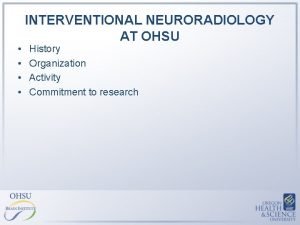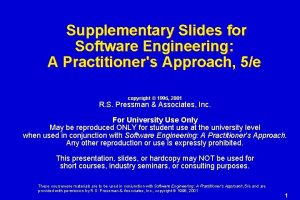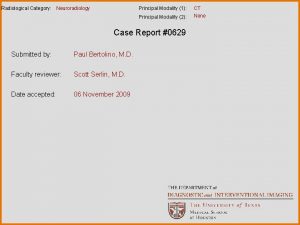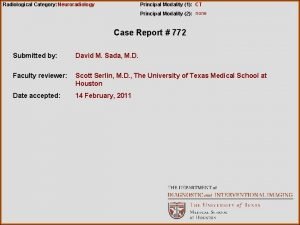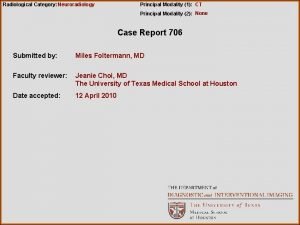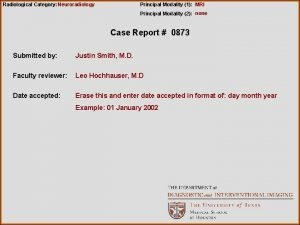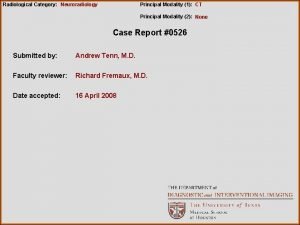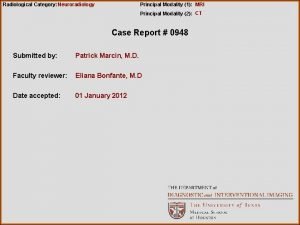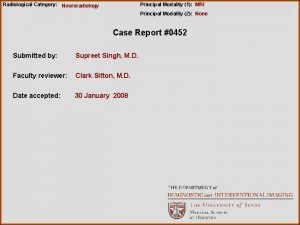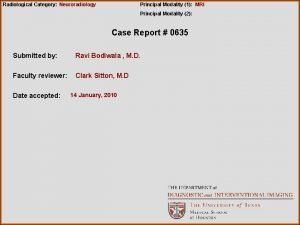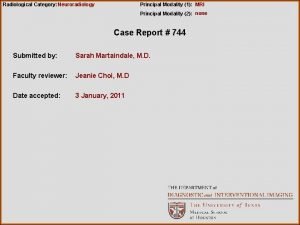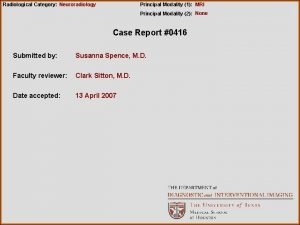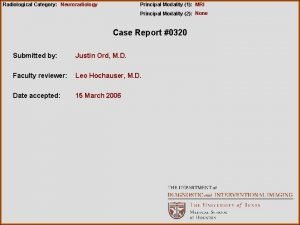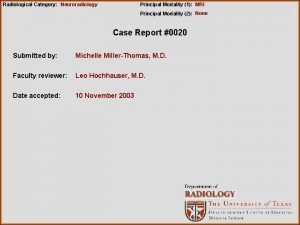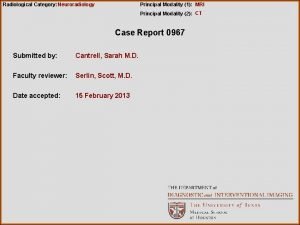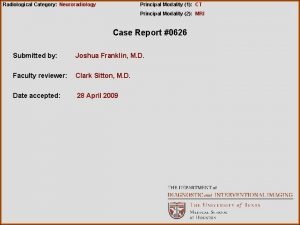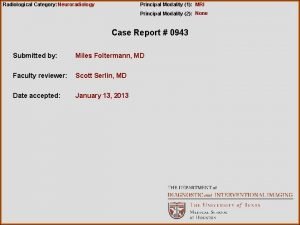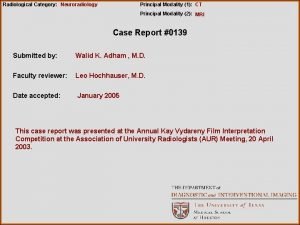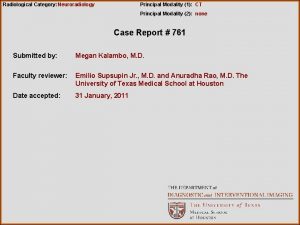Radiological Category Neuroradiology Principal Modality 1 MR Principal





















- Slides: 21

Radiological Category: Neuroradiology Principal Modality (1): MR Principal Modality (2): CT Case Report # 754 Submitted by: Miguel Fabrega , M. D. Faculty Reviewer: Leo Hochhauser, M. D. The University of Texas Medical School at Houston Date accepted: February 15, 2011

Case History 5 year old girl with unsteady gait

Radiological Presentations CT

Radiological Presentations CT

Radiological Presentations CT

Radiological Presentations T 2 FLAIR

Radiological Presentations T 1 POST CONTRAST T 1

Radiological Presentations DWI ADC

Radiological Presentations T 1 Post Gadolinium T 1 T 2

Radiological Presentations Sagital T 2

Radiological Presentations Sagital T 2

Radiological Presentations Sagital T 2

Test Your Diagnosis Which one of the following is your choice for the appropriate diagnosis? After your selection, go to next page. • Juvenile pilocytic astrocytoma • Brainstem glioma/astrocytoma • Medulloblastoma • Ependymoma

Findings and Differentials • Large posterior fossa mass in 4 ventricle, extends through foramen of Lushka • Hyperdense on CT • Isointense on T 1 with areas of enhancement • Heterogeneous, mostly hyperintense on T 2 • Areas of restricted diffusion • Obstructive hydrocephalus th Differentials: • Juvenile pilocytic astrocytoma • Brainstem glioma/astrocytoma • Medulloblastoma • Ependymoma

Discussion The most common posterior fossa masses in a child are: • Juvenile pilocytic astrocytoma • Brainstem glioma/astrocytoma • Medulloblastoma • Ependymoma

Discussion Brain Stem Gliomas/Astrocytomas - Expands the brainstem, most commonly occur in pons Moderate aggresiveness - Homogenous high signal on T 2 Mostly solid, 10% have cystic component Most do not enhance (67% do not) 4 th ventricle pushed posteriorly Usually do not produce hydrocephalus unless far advanced - Surgical resection usually not possible, treated with radiation This mass can be eliminated from the differential as it is clearly separate from the brainstem.

Discussion Juvenile Pilocytic Astrocytoma - Most common posterior fossa tumor Low grade tumor, best prognosis of CNS malignancies Arises from vermis or cerebellar hemispheres - Classically cystic (60 -80% in pediatric population) with enhancing mural nodule May be solid with heterogeneous enhancement Solid portion hypointense on T 1 and hyperintense on T 2 Well outlined from normal brain No restricted diffusion Displaces 4 th ventricle anteriorly No calcification or hemorrhage - Many require only surgical resection Although classically cystic, a solid mass does not exclude JPA. However, the mass in this case is within the 4 th ventricle rather than displacing it forward.

Discussion Ependymoma - Slow growing typically benign that arise from ependymal cells in the ventricles - Arises from floor of 4 th ventricle - Many calcify (50 -70%), typically punctate Typically iso to hypointense on non contrast CT Mild enhancement Hypointense on T 1 and intermediate on T 2, can be heterogeneous from hemmorrhage and necrosis Can extend through and widen foramen of Lushka and Magendie This lesion should remain on differential as it is within the 4 th ventricle and extends through the foramen of Lushka. However, it is hyperdense on nonenhanced CT and demonstrates restricted diffusion, both of which are not characteristic.

Discussion Medulloblastoma - Second most common posterior fossa tumor in children Most malignant Arises from roof of 4 th ventricle - Hyperdense on non con CT Usually diffuse homogeneous enhancement, though this may vary Hypointense on T 1 Hypo to mildly hyper on T 2 Hypercellular, show restricted diffusion - Hypointense on T 1 and intermediate on T 2 This is highest on differential given hyperdense appearance on CT and the presence of restricted diffusion (indicative of hypercellularity), features not seen in the other posterior fossa masses. The growth through the foramen of Lushka is not typically seen, as this mass is usually fast growing. Also, the enhancement is more heterogeneous than described in the literature.

Diagnosis Biopsy proven medulloblastoma

References 1. Brant WE, Helms CA, eds. Fundamentals of Diagnostic Radiology. 3 rd Edition. PA: Lippincott Williams & Wilkins; 2000: 147 -148. 2. Dahnert W. Radiology Review Manual. 6 th Edition. PA: Lippincott Williams & Wilkings; 2007: 292, 316, 335, 348, 733 -735. 3. Grossman RI, Yousem DM. Neuroradiology: The Requisites. 2 nd Edition. PA: Mosby; 2003: 532 -534
 Ohsu neuroradiology
Ohsu neuroradiology Aerohive erate
Aerohive erate National radiological emergency preparedness conference
National radiological emergency preparedness conference Radiological dispersal device
Radiological dispersal device Tennessee division of radiological health
Tennessee division of radiological health Center for devices and radiological health
Center for devices and radiological health Past tense in xhosa
Past tense in xhosa Characteristics of sensory neurons
Characteristics of sensory neurons Modality in software engineering
Modality in software engineering Epistemic modality
Epistemic modality Modality in software engineering
Modality in software engineering Cardinality and modality
Cardinality and modality Modality
Modality Modality microsoft services
Modality microsoft services Low modality examples
Low modality examples Epistemic modality
Epistemic modality Capacitive field diathermy
Capacitive field diathermy Modality stats
Modality stats Sodality vs modality
Sodality vs modality One to many relationship line
One to many relationship line Epistemic modality
Epistemic modality Cardinality and modality
Cardinality and modality
